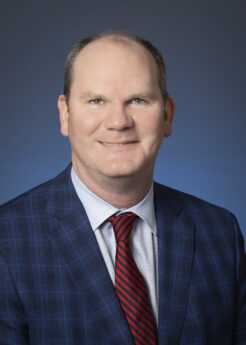HOME | ABOUT US | MEDIA KIT | CONTACT US | INQUIRE
HOME | ABOUT US | MEDIA KIT | CONTACT US | INQUIRE

The University of Kansas Health System and the University of Kansas Medical Center announce strategic alignment to fill four new leadership roles.
Posted August 15, 2024
The University of Kansas Medical Center announced it has selected a new executive vice chancellor in addition to the health system announcing three other senior leadership roles.
Dr. Steve Stites will serve as executive vice chancellor for KU Medical Center while also maintaining his role as executive vice president for clinical affairs and chief medical officer for the KU Health System, according to an announcement Thursday.

Dr. Steve Stites, executive vice chancellor for the University of Kansas Medical Center. Photo courtesy of The University of Kansas Health System.
Stites will be responsible for building a better connection between the two organizations, working with the research and education functions of the medical center with the clinical care it ultimately supports of the health system.
“As we look at the future of health care – in treatments, in developing the workforce of tomorrow and in how our academic medical center impacts our region – now is the time to make the necessary structural changes to allow us to meet tomorrow’s needs and opportunities,” University of Kansas Chancellor Dr. Doug Girod said.
Three more leadership appointments include:

Dr. Matthias Salathe, CRO for the University of Kansas and University of Kansas Medical Center. Photo courtesy of The University of Kansas Health System.
Dr. Matthias Salathe will serve as chief research officer for the University of Kansas and the KU Med Center. He will also serve as the chief medical officer for KU Health System. Salathe will be responsible for developing a research infrastructure spanning both organizations and increasing clinical trial opportunities.

Dr. Talal Kahn, senior associate dean for clinical affairs for KU School of Medicine. Photo courtesy of The University of Kansas Health System.
Dr. Talal Kahn will serve as senior associate dean for clinical affairs for the KU School of Medicine and continue serving as president of The University of Kansas Physicians as well as vice president of physician affairs for KU Health System.

Dr. Sean Kumer, senior vice president and CMO for the Kansas City division of The University of Kansas Health System. Photo courtesy of The University of Kansas Health System.
The organization also announced Dr. Sean Kumer will serve as senior vice president and chief medical officer for the Kansas City division of the KU Health System, and will continue his role in perioperative and procedural services.
Stites’ promotion, in addition to three other announced leadership roles, is part of a greater effort to form a robust and aligned clinical research infrastructure for the organizations. The strategic alignment aims to boost the recruiting and retaining of top researchers, become more competitive for research funding and increase clinical trial opportunities.